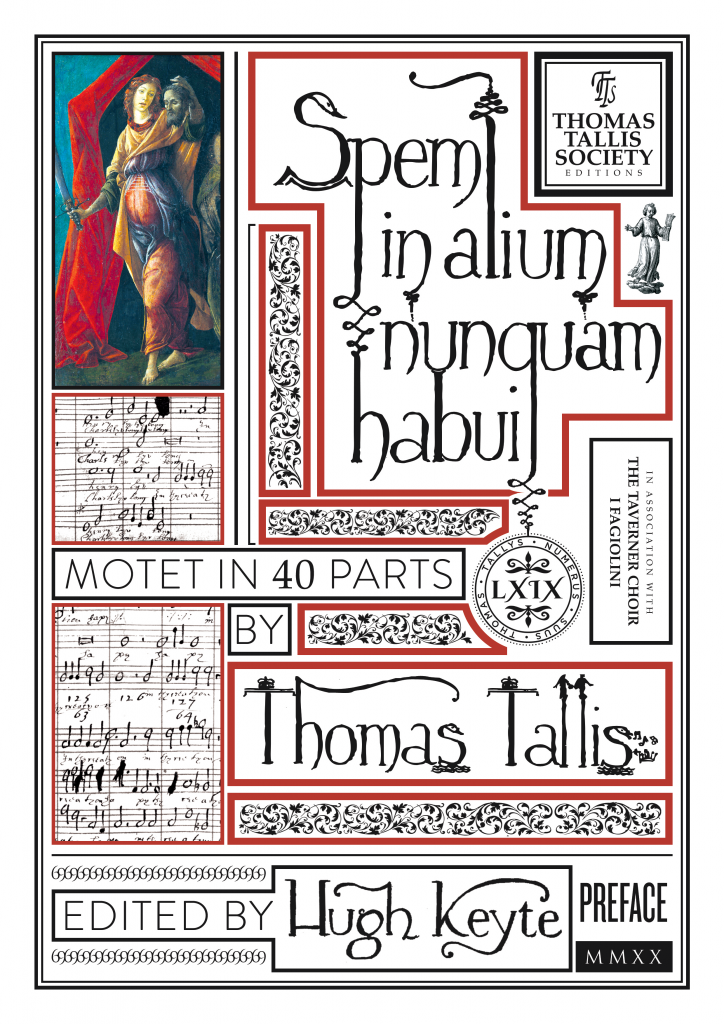Spem in alium – a Tallis’ Virtual Voice Choral Outreach Project
A free access, learning and performance resource
See Andrew Leslie-Cooper’s project preview video here
See Andrew Leslie-Cooper’s full 360 VR Video here
Choose your personalised learning resource here
Join the Choir of the Earth recording here
Preface to the TTS Edition of Spem in alium

Spem in alium
Thomas Tallis (c.1505-1585)
Hugh Keyte’s edition of this famous motet, made freely available by the
Thomas Tallis Society to celebrate the likely 450th anniversary of the first performance.
Foreword
Most choral singers will have heard Tallis’s celebrated motet on record, or in concert, but relatively few will have had the opportunity to get to know it through performance, if only because of the difficulty of meeting up with at least thirty-nine other singers who can hold the often complex polyphonic lines. Members of the Thomas Tallis Society chamber choir are lucky in this respect, being able to join with enough singing colleagues who can do this, and to do so before a loyal audience of Friends and Patrons in the wonderful Hawksmoor church of St Alfege in Greenwich beneath which Tallis and his wife lie buried. (We perform the complete range of choral works, ancient and modern, though we do have a special allegiance to the music of Tallis.)
As part of our programme of outreach and social connection we have long wished to find a way of sharing our experience and pleasure of musicmaking with others, and of Tallis’s choral masterpieces in particular. This became especially pertinent with the advent of Covid-19, with lock-downs and the need for social distancing making it impossible for singers to join together to sing at all, let alone perform works on the scale of ‘Spem in alium’, at least in the short term. Hence our Tallis’ Virtual Voice programme, which aims to enable anyone, singer or instrumentalist, individual or small group, to join in a virtual performance of Tallis’s monumental work – or, indeed, to create their own customised version. All this is being provided online, and there are two main elements. Firstly, we are making freely available for the first time Hugh Keyte’s edition of the motet. This differs radically in many respects from all other available editions in that, surprisingly, it is the first to have been produced directly from the earliest surviving source, which Hugh asserts has allowed him to get much closer to what Tallis will actually have written. We are presenting this in a user-friendly way with choir books that can be printed at A4 and relieve singers of the need to wrestle with a vast andscape of paper. These choirbooks contain the relevant choir part enlarged to be legible with the parts of the other choirs reduced. Full conductor’s scores can also be downloaded, but may need to be printed at A3 or A2 size for practical use. The work and the edition are described briefly in Hugh’s Preface below, and in much greater detail in his Introduction , which is downloadable from our website, alongside the freely available scores in a variety of formats.
Secondly, we have commissioned from Andrew Leslie Cooper, a remarkable singer with the requisite three-octave range, a recording of all forty voice parts of the motet in a single performance. This can be listened to complete, but each individual voice part can also be downloaded as a single track to which users can sing (or play) along; or they might use it to learn that particular part, which they can then add to the other thirty-nine as sung by Andrew to create a bespoke virtual performance. Alternatively, new parts such as a saxophone improvisation might be added to Andrew’s 40 recorded parts to produce a truly personalised performance. The combination of online recording, musical edition, and Introduction is very much a technological ‘work in progress’, and we plan to make all of this freely available in the most convenient and easily-accessed ways we can achieve.
In order to cater for musical taste, two versions of Hugh’s edition will eventually be available. One is the version he produced for the Taverner Choir double LP of the complete Latin church music of Tallis in 1986, and this is the one that Andrew Leslie Cooper has recorded. The other is the revision which Hugh made for the I Fagiolini CD of Striggio’s 40-part mass in 2011, which differs both in the amount of editorial sharpenings (ficta), in underlay, and in the suggested use of instruments. A similar downloadable recording of this version will be made by the choir of the Thomas Tallis Society as soon as the abatement of the present pandemic allows.
I encourage you to seek out all these resources via our websites www.thomas-tallis-society.org.uk and www.tallisvirtualvoice.org, and particularly to read Hugh’s Introduction, which (for one thing) will explain Botticelli’s painting of Judith with severed head of Holofernes on the front of this copy, that may have been puzzling you. It is a fascinating musical, historical and social journey that involves cryptology and regicidal intrigue, and explains how Tallis’ musical masterwork may have come about: which is far different from what has been generally assumed.
Nigel Press, Chairman TTS
Preface to the TTS Edition of Spem in alium – click here for the full document